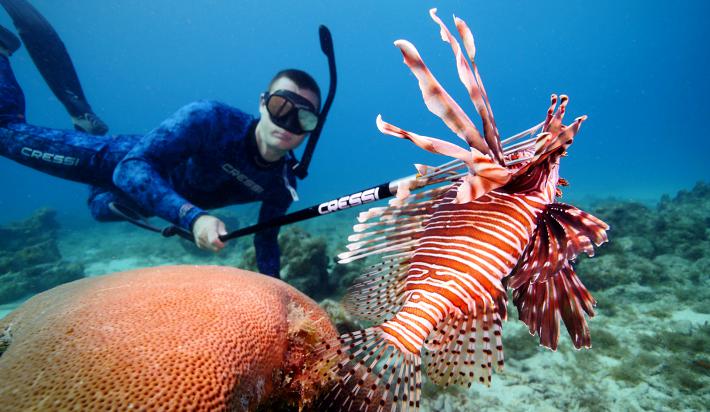
Tackling The Invasive Lionfish Epidemic
Above photo courtesy of Florida Sportsman.
There's been a ton of buzz lately, in the marine community and beyond, about a growing under-water crisis requiring all hands on deck to slow down its progression. With awareness spreading the way it thankfully is, chances are you've heard about or come face-to-face with the invasive lionfish. These dangerous, poisonous sea creatures may look cool but they are reaping environmental havoc across reefs and sandy bottoms throughout the Atlantic and Caribbean. The Indo-Pacific native lionfish, with its unmistakable stripes, spikes and fan-like fins, looks like it belongs in an exotic aquarium, but since the mid 1980's the species has been unnaturally spreading throughout western Atlantic waters, including the Gulf of Mexico and Caribbean Sea.
With absolutely no natural predators to keep this invasive species at bay and incredibly high reproduction numbers, we're talking 25,000 eggs every four days over a 30 year lifespan, lionfish are disrupting native fish populations at alarming rates. These carnivorous intruders have insatiable appetites and their damage is done by aggressively competing for food and space with overfished snapper, grouper and the like, while simultaneously killing off helpful native species such as the algae-eating parrotfish, allowing growth to overtake reefs. National Geographic gives us an in-depth break down of the threat posed by lionfish and explains how divers are helping researchers catch the fish to learn more about its biology and develop ways to control the population.
The negative impact lionfish have on native Atlantic species and habitat is a huge cause for concern but thanks to dedicated activists, marine conservation organizations, lionfish derbies and state-of-the-art technology, humans have a fighting chance in the battle against the Lionfish epidemic. There are a multitude of programs and lionfish round-ups held year round throughout Florida, so if you're an angler, spearfisherman or diver, or if you simply share a passion for the ocean like many of us do, get involved in waters near you to protect our native reefs and species. Florida's statewide lionfish challenge, facilitated by the FWC, runs from May 14 - September 30, 2017. A recreational fishing license is not required for recreationally targeting lionfish while using a pole spear, a Hawaiian Sling, a handheld net (not recommended) or any spearing device that is specifically designed and marketed exclusively for lionfish. Click here to sign up for the challenge which netted over 16,000 last year.
Photo: Reefrangers.com
Harvesting the lionfish not only helps in the essential removal effort but the white, buttery meat of this fish, similar to pollock or snapper, makes for fantastic eating and is perfectly safe. They are slow-moving fish making them an easy target for even a novice spearfisherman and because they are a demersal species, they live on the ocean floor, often under ledges and in crevices, and are more active during the evening. Just watch out for their 18 spines, both when collecting and cleaning the fish, as they deliver a venomous sting that can last for days and cause extreme pain, sweating, respiratory distress, and even paralysis. For safety, many divers will use a containment device while harvesting such as the popular Zookeeper unit. While it's a daunting task, divers are definitely doing their part to help with over 111,000 lionfish removed from waters in 2016 according to the Reef Rangers Lionfish Control Program.
 Photo: Reefrangers.com
Photo: Reefrangers.com
The latest, most inventive tool aiding in the battle against the lionfish is a predator of the robotic kind. Engineered by the non-profit organization Robots in Service of the Environment (RSE), the Guardian LF1 is a submersible robot deployed into the sea and able to reach depths of 400 feet where scientists believe Lionfish do most of their breeding. Designed to guard and protect our reefs, the robot locates and stuns, but doesn't kill the lionfish and then it sucks them into the robot. It does this over and over again, until full of unconscious fish and then rises to the surface where the catch is unloaded and ideally delivered to waiting restaurants and seafood markets. Making the lionfish a popular seafood item is the long-term goal for controlling the spread of the species.
The Guardian LF1 gained the attention of America's Cup sailboat racing team, Land Rover BAR along with some of their partners, and with their support and promotion, RSE launched their first initiative in Bermuda where the invasion is prevalent and potentially devastating. The lionfish successfully removed by the Guardian LF1 were used at an America's Cup cook-off event, the Celebrity Chef Lionfish Throwdown, sponsored by 11th Hour Racing. Eventually, RSE hopes to turn lionfish hunting with the Guardian LF1 into a sort of online game that can anyone can "play" remotely from a smartphone app. To support RSE's Kickstarter campaign for their continued success with the Lionfish project, click here.
If you've spotted a lionfish in your area while diving, please report it here or download the app developed by the Florida Fish and Wildlife Conservation Commission for easier and faster reporting.

